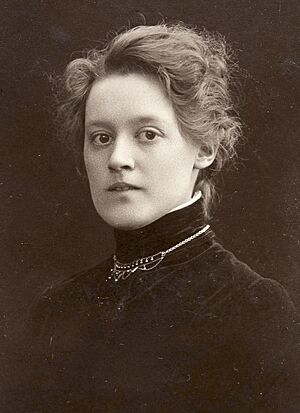Maggie Gripenberg facts for kids
Margarita Maria “Maggie” Gripenberg (born June 11, 1881 – died July 28, 1976) was a very important dancer in Finland. She was one of the first people to bring Dalcroze Eurhythmics to Finland. This is a way of learning music through movement. Maggie Gripenberg also based her early dances on the free style of Isadora Duncan.
As a dancer, a person who creates dances (choreographer), and a teacher, she helped start dance education in Finland. She received many awards for her dance work. She was also given the Pro Finlandia Medal and was made a knight of the Order of the White Rose of Finland. These are very special honors in Finland.
Contents
Early Life and Dance Training
Margarita Maria Gripenberg was born on June 11, 1881, in Helsinki, Finland. Her father, Sebastian Gripenberg, was an architect. He became a high-ranking government official. Maggie was the oldest of three children. Her aunt, Alexandra Gripenberg, was a leader in the movement for women's rights in Finland.
From a young age, Maggie wanted to be a dancer. She often performed for her family. But because her family was well-known, dancing was not seen as a proper job for her. Her parents did encourage her to study other arts, like singing, piano, and painting.
After studying at the Academy of Fine Arts, Helsinki, Maggie continued painting courses. In 1905, she saw a performance by Isadora Duncan in Dresden, Germany. This show truly inspired her. Between 1906 and 1909, Maggie kept studying art in Paris. But she felt that painting was not her true path.
In 1909, the director of the Finnish National Theatre asked Maggie to teach movement. She felt she wasn't ready. So, she agreed only if she could take more dance classes first. She went to Stockholm, Sweden, and studied with Anna Behle. Anna then took her to Geneva, Switzerland. There, they trained with Émile Jaques-Dalcroze in the summer of 1910. To pay for more training, Maggie and Anna performed in Norway and Sweden. This allowed them to study longer at the Dalcroze Institute in Dresden. Maggie learned very quickly. In June 1911, she earned her diploma.
Maggie Gripenberg's Dance Career
Maggie Gripenberg performed for the first time at the National Theater on November 13, 1911. She danced barefoot to music by famous composers like Chopin and Sibelius. Everyone loved her performance. Her aunt Alexandra suggested she use a different name if she kept dancing. This was because dancing was still not fully accepted for women from her background.
Maggie did not use a different name. She danced in flowing costumes and a free, rhythmic style. She was a pioneer of modern dance in Finland. Her choice soon inspired other women from good families to become dancers. Many also enrolled their children in her dance classes. Before 1915, Maggie mostly performed alone or with her students. In 1912, a painting showed her and her dance group in Greek costumes. In 1914, she began teaching at the Sibelius Academy. She also continued her work at the National Theater.

During the 1910s and 1920s, Maggie toured with her dance company. They performed in the Baltic states, England, Sweden, and the United States. She often danced duets with Onni Gabriel Snell. Some of their dances were Bacchanale and Two Gypsies. Their partnership ended in 1921 when Onni stayed in the US. After that, Maggie sometimes danced with Kaarlo Eronen and Elo Kuosmanen. In 1918, she appeared in a film called Nobelpristagaren (Nobel Prize Winner). This was her only film role.
Maggie Gripenberg became more focused on creating dances. She made over 100 dances during her career. Some of her most famous works included dances for Orfeus (1926) and Stormen (The Tempest, 1929) by Sibelius. She also choreographed for The Dybbuk (1934) and Sleeping Beauty (1937).
After 1932, Maggie focused only on teaching and creating dances. She let other dancers perform her works. Her choreography was influenced by Isadora Duncan. She took Duncan's free style and made it into modern dance. Her dances had strong, geometric movements. They used musical rhythm with smooth steps and controlled arm movements.
Maggie won first prize for her choreography in Brussels in 1939. Her five-woman group performed dances like Gossip and Slavery. In 1945, she won third place in a competition in Stockholm for her dance Life Continues. She won third prize again in 1947 for Misguided in Copenhagen.
As a teacher, Maggie continued at the National Theater and Sibelius Academy until 1952. She also had her own private dance studio. From 1934 to 1951, she taught at the Swedish Theatre. She also taught at the University of Helsinki from 1938 to 1949. She taught at many summer camps and festivals too. During summers, she taught in Denmark and Sweden. Maggie also wrote articles about dance for newspapers and magazines. Her autobiography, Rytmin lumoissa (Spellbound by Rhythm), was published in 1950.
Finland honored Maggie Gripenberg with three medals. She received a medal for her participation in the War for Freedom (1939-1940). In 1951, she was given the Pro Finlandia Medal of the Order of the Lion of Finland. In 1961, she was honored as a knight in the Order of the White Rose of Finland. Maggie Gripenberg never married. She retired with a friend to Åland.
Death and Legacy
Maggie Gripenberg passed away on July 28, 1976, in Mariehamn. She was one of the first women to be buried in Helsinki's Artists Knoll in the Old Cemetery. She is remembered as a pioneer in dance. She brought the rhythmic style of Dalcroze to Finland. Her ideas helped create the foundation for Eurhythmy as a way of studying movement and dance in Finland.
Images for kids
-
Gripenberg as Syrinx dancing with Pan, by Venny Soldan-Brofeldt in 1910s







